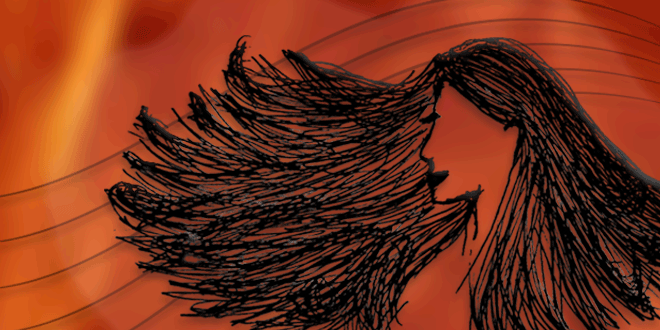Album Review: Tori Amo’s “Boys for Pele”

Design by Meva Himmetoglu
21 years later, Tori Amos’ epic album “Boys for Pele” remains as relevant as ever. An 18-song cycle through which Amos examines love and religion in a world dominated by patriarchal norms, “Boys for Pele” uses the feminine as a weapon excision against misogyny and sexism. In other words, Amos wages war, with the resultant triumph of reclaiming the feminine. Amos does not come away from the battle without injury. But these injuries act as testament to her resilience, rather than loss.
Amos’ offensive strategy against patriarchy begins with the album title, which alludes to the Hawaiian goddess of fire, lightning, wind, and volcanoes, Pele. As a title, “Boys for Pele” acts a manifesto. It strongly points to the ritualistic sacrifice of male bodies to a female deity. In a larger context, the sacrifice also suggests the deference of masculinity to femininity. She continues the attack with the album cover—Amos, mud stained and barefoot, cradling a hunting rifle in a rocking chair on a backwoods porch. A snake slithers along the left side of the chair. To her right, a dead rooster is strung upside down from the roof. With this image, Amos points to the intersectionality of gender, sexuality and religion.
The music of “Pele” spans music idioms from classical Western music to the pop and alternative music of the mid-90’s. Amos still works within the unique singer-songwriter framework she carved out with her solo debut, “Little Earthquakes”—a blend of classical piano, acapella, folk, glam, soft and pop rock forms—however, she expands her palette, incorporating jazz, funk, and electronics. Perhaps Amos’ most daring move involves her utilization of the harmonium and, most notably, the harpsichord. Amos takes the harpsichord and filters it through a rock lens via the blistering performances of “Blood Roses” and “Professional Widow”. “Widow” goes for the jugular as Amos pounds away on the harpsichord supported by funky bass, programmed beats, acoustic drums, and the looped wail of a provoked bull. Her single “Caught a Lite Sneeze,” employs industrial textures, percussion, bass, harpsichord and piano. “Talula (Album Version)” incorporates classical Baroque and New Orleans R&B into something uniquely Amos, uniquely “Pele.”
Despite the experimentation, it would not be a Tori Amos album without a set of arresting piano ballads. Opener “Beauty Queen / Horses” and closer “Twinkle” trade on the fullness of space between sustained piano notes. “Hey Jupiter (Album Version)” takes glam rock’s theatricality and pares it down to a confessional filtered through the trope of poetic persona. “Father Lucifer” is a stately ballad in which Amos makes peace with humanity’s dark side.
Since her solo debut, Amos has never been one to shy away from tropes, being more consciously poetic than other singer-songwriters. On “Boys for Pele,” she ratchets it up to near inscrutable levels. However, that inscrutability can prove irresistible given repeated listens and close readings. Take for instance, a verse from “Muhammad My Friend”:
“And Moses, I know
I know you’ve seen fire
But you’ve never seen fire
Until that you’ve seen Pele blow
And I’ve never seen light
But I sure have seen gold
And Gladys save a place for me on your grapevine
Till I get my own TV show”
It’s difficult to pin down Amos’ exact meaning, but what comes through points to a sense of desire, a want to search, and a longing to claim a place for one’s self.
Not all of the album’s text is impenetrable. “Marianne” eulogizes a high school classmate’s teen suicide. “Putting the Damage On” tells of the pendulum of desire through the lens of a failing romantic relationship. And even amongst the inscrutability, several lines act as anchors for the listener throughout the album—“I shaved every place that you’ve been, boy” (“Blood Roses”); “I need a big loan from a girl zone” (“Caught a Lite Sneeze”); “And if I’m hanging on to your shade / I guess I’m way beyond the pale” (“Doughnut Song”).
“Boys for Pele” remains relevant to our contemporary moment because women still find themselves affected by the hegemony of patriarchy. With a predatory president in office, and a woman’s right to choose heavily contested and under civil threat, “Boys for Pele” functions as a vehicle for listeners to utilize the power of the feminine and rage against the misogynistic powers that be. Not only that, it functions as a site of vulnerability where listeners can fall apart and recuperate, if need be.
TLDR: “Boys for Pele” kicks ass.




